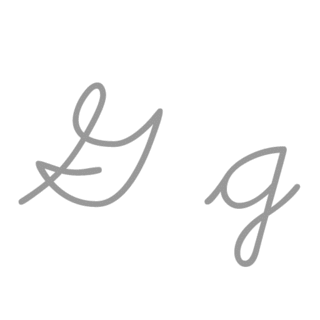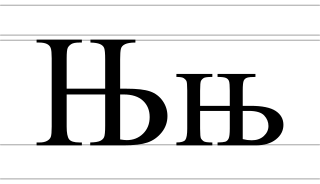NJ is the abbreviation for the U.S. state of New Jersey.
Contents
Nj or NJ may also stand for:
NJ is the abbreviation for the U.S. state of New Jersey.
Nj or NJ may also stand for:
A&W, AW, Aw, aW or aw may refer to:

G, or g, is the seventh letter in the Latin alphabet, used in the modern English alphabet, the alphabets of other western European languages and others worldwide. Its name in English is gee, plural gees.
GN may refer to:
ZH or Zh may refer to:

In writing and typography, a ligature occurs where two or more graphemes or letters are joined to form a single glyph. Examples are the characters æ and œ used in English and French, in which the letters 'a' and 'e' are joined for the first ligature and the letters 'o' and 'e' are joined for the second ligature. For stylistic and legibility reasons, 'f' and 'i' are often merged to create 'fi' ; the same is true of 's' and 't' to create 'st'. The common ampersand (&) developed from a ligature in which the handwritten Latin letters 'E' and 't' were combined.

A digraph or digram is a pair of characters used in the orthography of a language to write either a single phoneme, or a sequence of phonemes that does not correspond to the normal values of the two characters combined.
NN, Nn, or nn may refer to:
En or EN may refer to:
HL may refer to:

Nje is a letter of the Cyrillic script.

Dzhe or Gea is a letter of the Cyrillic script used in Macedonian and varieties of Serbo-Croatian to represent the voiced postalveolar affricate, like the pronunciation of j in “jump”.

Gaj's Latin alphabet, also known as abeceda or gajica, is the form of the Latin script used for writing Serbo-Croatian and all of its standard varieties: Bosnian, Croatian, Montenegrin, and Serbian.
Ny is a digraph in a number of languages such as Catalan, Ganda, Filipino/Tagalog, Hungarian, Swahili and Malay. In most of these languages, including all of the ones named above, it denotes the palatal nasal. To represent the palatal nasal in other languages, the letter nj is used, such as in Albanian and the countries using Gaj's Latin alphabet and the countries that make up the former Yugoslavia.
Nj is a letter present in South Slavic languages such as the Latin-alphabet version of Serbo-Croatian and in romanised Macedonian. It is also used in the Albanian alphabet. In all of these languages, it represents the palatal nasal. It is pronounced as Dom Pérignon. For example, the Croatian, Bosnian and Serbian word konj is pronounced.
The romanization of Macedonian is the transliteration of text in Macedonian from the Macedonian Cyrillic alphabet into the Latin alphabet. Romanization can be used for various purposes, such as rendering of proper names in foreign contexts, or for informal writing of Macedonian in environments where Cyrillic is not easily available. Official use of romanization by North Macedonia's authorities is found, for instance, on road signage and in passports. Several different codified standards of transliteration currently exist and there is widespread variability in practice.

Prior to the arrival of Europeans, Australian Aboriginal languages had been purely spoken languages, and had no writing system. On their arrival, Latin script became a standard for transcription of Australian Aboriginal languages, but the details of how the sounds were represented has varied over time and from writer to writer, sometimes resulting in a great many variant spellings of the same word or name.
The Fula language is written primarily in the Latin script, but in some areas is still written in an older Arabic script called the Ajami script or in the recently invented Adlam script.

The Van Ophuijsen Spelling System was used as the orthography for the Indonesian language from 1901 to 1947. Before the Van Ophuijsen Spelling System was in force, the Malay language in the Dutch East Indies did not have a standardized spelling, or was written in the Jawi script. In 1947, the Van Ophuijsen Spelling System was replaced by the Republican Spelling System.